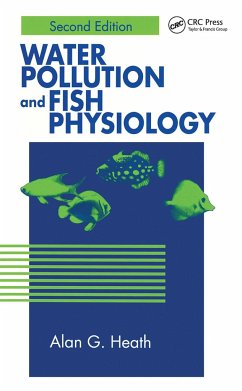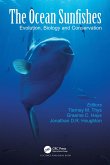Alan G Heath
Water Pollution and Fish Physiology
Alan G Heath
Water Pollution and Fish Physiology
- Broschiertes Buch
- Merkliste
- Auf die Merkliste
- Bewerten Bewerten
- Teilen
- Produkt teilen
- Produkterinnerung
- Produkterinnerung
This book provides a reasonably concise synthesis of what is known about how pollutants affect physiological processes in fish, providing a discussion of some concepts that are important in understanding pollution biology and fish physiology.
Andere Kunden interessierten sich auch für
![The Ocean Sunfishes The Ocean Sunfishes]() The Ocean Sunfishes94,99 €
The Ocean Sunfishes94,99 €![Quabbin, the Accidental Wilderness Quabbin, the Accidental Wilderness]() Thomas ConuelQuabbin, the Accidental Wilderness28,99 €
Thomas ConuelQuabbin, the Accidental Wilderness28,99 €![This Land, This South This Land, This South]() Albert E CowdreyThis Land, This South29,99 €
Albert E CowdreyThis Land, This South29,99 €![A Fish Caught in Time A Fish Caught in Time]() Samantha WeinbergA Fish Caught in Time19,99 €
Samantha WeinbergA Fish Caught in Time19,99 €![Immunobiology of the Shark Immunobiology of the Shark]() Immunobiology of the Shark91,99 €
Immunobiology of the Shark91,99 €![Brachiopods Brachiopods]() Paul CopperBrachiopods91,99 €
Paul CopperBrachiopods91,99 €![The Alewives' Tale The Alewives' Tale]() Barbara BrennesselThe Alewives' Tale31,99 €
Barbara BrennesselThe Alewives' Tale31,99 €-
-
-
This book provides a reasonably concise synthesis of what is known about how pollutants affect physiological processes in fish, providing a discussion of some concepts that are important in understanding pollution biology and fish physiology.
Hinweis: Dieser Artikel kann nur an eine deutsche Lieferadresse ausgeliefert werden.
Hinweis: Dieser Artikel kann nur an eine deutsche Lieferadresse ausgeliefert werden.
Produktdetails
- Produktdetails
- Verlag: Taylor & Francis Ltd (Sales)
- 2nd edition
- Seitenzahl: 384
- Erscheinungstermin: 2. Dezember 2019
- Englisch
- Abmessung: 229mm x 152mm x 20mm
- Gewicht: 499g
- ISBN-13: 9780367448929
- ISBN-10: 0367448920
- Artikelnr.: 58440759
- Herstellerkennzeichnung
- Libri GmbH
- Europaallee 1
- 36244 Bad Hersfeld
- gpsr@libri.de
- Verlag: Taylor & Francis Ltd (Sales)
- 2nd edition
- Seitenzahl: 384
- Erscheinungstermin: 2. Dezember 2019
- Englisch
- Abmessung: 229mm x 152mm x 20mm
- Gewicht: 499g
- ISBN-13: 9780367448929
- ISBN-10: 0367448920
- Artikelnr.: 58440759
- Herstellerkennzeichnung
- Libri GmbH
- Europaallee 1
- 36244 Bad Hersfeld
- gpsr@libri.de
Heath, Alan G.
Some Introductory Concepts: Types of Water Pollution. The Relationship
Between Aquatic Toxicology and Fish Physiology. Levels of Biological
Organization. Importance of Dose and Duration of Exposure. Stress. Toxic
Mode of Action.
Environmental Hypoxia: Minimum Levels of Oxygen Required for Fish Life.
Interaction of Hypoxia and Toxicity of Pollutant Chemicals. Gill vs.
Cutaneous Respiration. Adjustments in Ventilation. Adjustments by the Gills
to Hypoxia. Transport of Oxygen by the Blood. Cardiovascular Changes During
Hypoxia. Respiratory Regulation and Conformity. Anaerobic Metabolism.
Swimming Speed. Behavior. Blood and Urine. Histopathology. Acclimation to
Hypoxia.
Respiratory and Cardiovascular Responses: Overview of Normal Respiratory
Physiology. Histopathology of Gill Lamellae Exposed to Pollutants.
Ventilation Changes in Response to Pollutants. Physiological Mechanisms of
Changes in Ventilation. Circulatory Physiology. Cardiac Responses to
Pollutants.
Hematology: Fish Blood Cells and their Measurement. Chemicals that Cause
Anemia. Chemicals Causing an Increase in Hematological Variables.
Uptake, Accumulation, Biotransformation, and Excretion of Xenobiotics:
Uptake from the Environment. Transport Within the Fish of Metals and
Organics. Accumulation of Metals in Different Organs. Regulation of Metal
Concentration. Glutathione and Metal Detoxification. Involvement of
Metallothionein in Metal Accumulation and Acclimation to Metals.
Bioconcentration of Organic Pollutants. Biotransformation of Organic
Contaminants. Excretion of Organic Contaminants.
Liver: Structure of Liver. Alterations of Liver/Somatic Index.
Histopathological Effects of Pollutants. Major Functions of Liver. Effects
of Pollutants on Liver Function. Ascorbic Acid and Pollutant Exposure.
Osmotic and Ionic Regulation: Effects of Pollutants on Osmotic and Ionic
Regulation. Mucus. Chloride Cell Proliferation. Some Summary Comments
Regarding Osmoregulatory and Electrolyte Alterati
Between Aquatic Toxicology and Fish Physiology. Levels of Biological
Organization. Importance of Dose and Duration of Exposure. Stress. Toxic
Mode of Action.
Environmental Hypoxia: Minimum Levels of Oxygen Required for Fish Life.
Interaction of Hypoxia and Toxicity of Pollutant Chemicals. Gill vs.
Cutaneous Respiration. Adjustments in Ventilation. Adjustments by the Gills
to Hypoxia. Transport of Oxygen by the Blood. Cardiovascular Changes During
Hypoxia. Respiratory Regulation and Conformity. Anaerobic Metabolism.
Swimming Speed. Behavior. Blood and Urine. Histopathology. Acclimation to
Hypoxia.
Respiratory and Cardiovascular Responses: Overview of Normal Respiratory
Physiology. Histopathology of Gill Lamellae Exposed to Pollutants.
Ventilation Changes in Response to Pollutants. Physiological Mechanisms of
Changes in Ventilation. Circulatory Physiology. Cardiac Responses to
Pollutants.
Hematology: Fish Blood Cells and their Measurement. Chemicals that Cause
Anemia. Chemicals Causing an Increase in Hematological Variables.
Uptake, Accumulation, Biotransformation, and Excretion of Xenobiotics:
Uptake from the Environment. Transport Within the Fish of Metals and
Organics. Accumulation of Metals in Different Organs. Regulation of Metal
Concentration. Glutathione and Metal Detoxification. Involvement of
Metallothionein in Metal Accumulation and Acclimation to Metals.
Bioconcentration of Organic Pollutants. Biotransformation of Organic
Contaminants. Excretion of Organic Contaminants.
Liver: Structure of Liver. Alterations of Liver/Somatic Index.
Histopathological Effects of Pollutants. Major Functions of Liver. Effects
of Pollutants on Liver Function. Ascorbic Acid and Pollutant Exposure.
Osmotic and Ionic Regulation: Effects of Pollutants on Osmotic and Ionic
Regulation. Mucus. Chloride Cell Proliferation. Some Summary Comments
Regarding Osmoregulatory and Electrolyte Alterati
Some Introductory Concepts: Types of Water Pollution. The Relationship
Between Aquatic Toxicology and Fish Physiology. Levels of Biological
Organization. Importance of Dose and Duration of Exposure. Stress. Toxic
Mode of Action.
Environmental Hypoxia: Minimum Levels of Oxygen Required for Fish Life.
Interaction of Hypoxia and Toxicity of Pollutant Chemicals. Gill vs.
Cutaneous Respiration. Adjustments in Ventilation. Adjustments by the Gills
to Hypoxia. Transport of Oxygen by the Blood. Cardiovascular Changes During
Hypoxia. Respiratory Regulation and Conformity. Anaerobic Metabolism.
Swimming Speed. Behavior. Blood and Urine. Histopathology. Acclimation to
Hypoxia.
Respiratory and Cardiovascular Responses: Overview of Normal Respiratory
Physiology. Histopathology of Gill Lamellae Exposed to Pollutants.
Ventilation Changes in Response to Pollutants. Physiological Mechanisms of
Changes in Ventilation. Circulatory Physiology. Cardiac Responses to
Pollutants.
Hematology: Fish Blood Cells and their Measurement. Chemicals that Cause
Anemia. Chemicals Causing an Increase in Hematological Variables.
Uptake, Accumulation, Biotransformation, and Excretion of Xenobiotics:
Uptake from the Environment. Transport Within the Fish of Metals and
Organics. Accumulation of Metals in Different Organs. Regulation of Metal
Concentration. Glutathione and Metal Detoxification. Involvement of
Metallothionein in Metal Accumulation and Acclimation to Metals.
Bioconcentration of Organic Pollutants. Biotransformation of Organic
Contaminants. Excretion of Organic Contaminants.
Liver: Structure of Liver. Alterations of Liver/Somatic Index.
Histopathological Effects of Pollutants. Major Functions of Liver. Effects
of Pollutants on Liver Function. Ascorbic Acid and Pollutant Exposure.
Osmotic and Ionic Regulation: Effects of Pollutants on Osmotic and Ionic
Regulation. Mucus. Chloride Cell Proliferation. Some Summary Comments
Regarding Osmoregulatory and Electrolyte Alterati
Between Aquatic Toxicology and Fish Physiology. Levels of Biological
Organization. Importance of Dose and Duration of Exposure. Stress. Toxic
Mode of Action.
Environmental Hypoxia: Minimum Levels of Oxygen Required for Fish Life.
Interaction of Hypoxia and Toxicity of Pollutant Chemicals. Gill vs.
Cutaneous Respiration. Adjustments in Ventilation. Adjustments by the Gills
to Hypoxia. Transport of Oxygen by the Blood. Cardiovascular Changes During
Hypoxia. Respiratory Regulation and Conformity. Anaerobic Metabolism.
Swimming Speed. Behavior. Blood and Urine. Histopathology. Acclimation to
Hypoxia.
Respiratory and Cardiovascular Responses: Overview of Normal Respiratory
Physiology. Histopathology of Gill Lamellae Exposed to Pollutants.
Ventilation Changes in Response to Pollutants. Physiological Mechanisms of
Changes in Ventilation. Circulatory Physiology. Cardiac Responses to
Pollutants.
Hematology: Fish Blood Cells and their Measurement. Chemicals that Cause
Anemia. Chemicals Causing an Increase in Hematological Variables.
Uptake, Accumulation, Biotransformation, and Excretion of Xenobiotics:
Uptake from the Environment. Transport Within the Fish of Metals and
Organics. Accumulation of Metals in Different Organs. Regulation of Metal
Concentration. Glutathione and Metal Detoxification. Involvement of
Metallothionein in Metal Accumulation and Acclimation to Metals.
Bioconcentration of Organic Pollutants. Biotransformation of Organic
Contaminants. Excretion of Organic Contaminants.
Liver: Structure of Liver. Alterations of Liver/Somatic Index.
Histopathological Effects of Pollutants. Major Functions of Liver. Effects
of Pollutants on Liver Function. Ascorbic Acid and Pollutant Exposure.
Osmotic and Ionic Regulation: Effects of Pollutants on Osmotic and Ionic
Regulation. Mucus. Chloride Cell Proliferation. Some Summary Comments
Regarding Osmoregulatory and Electrolyte Alterati








